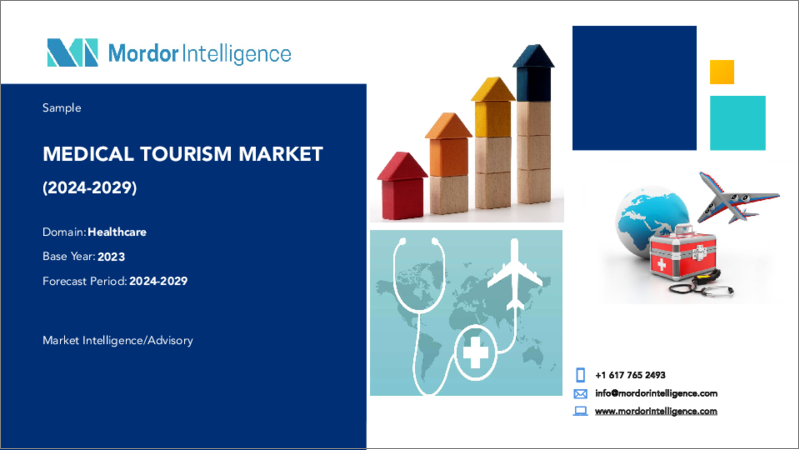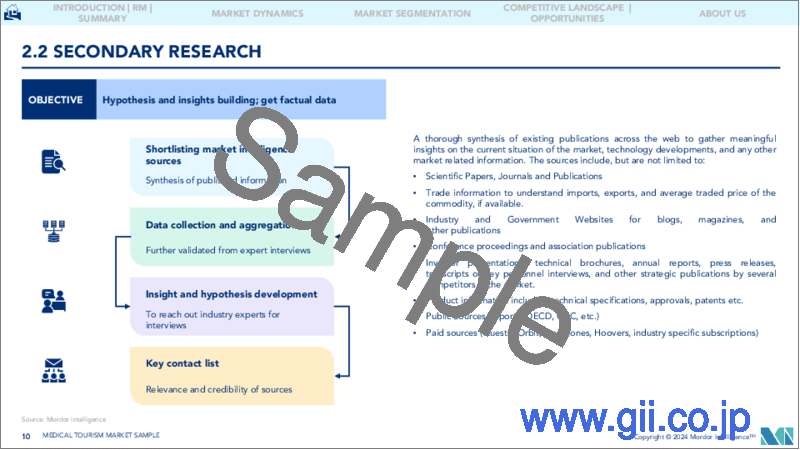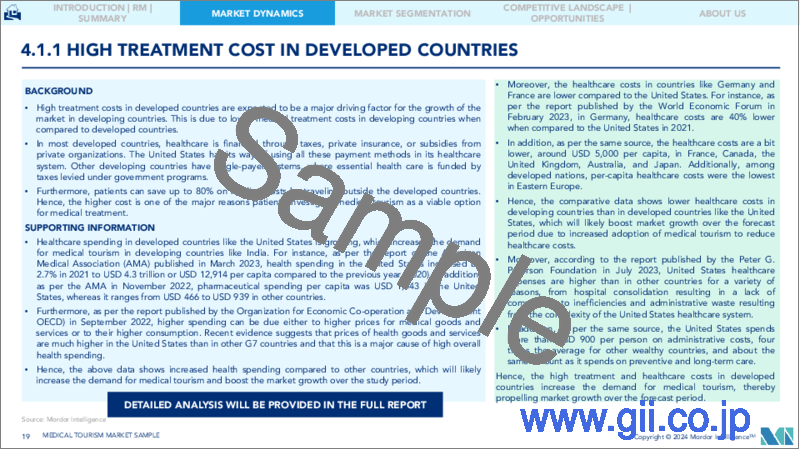|
|
市場調査レポート
商品コード
1403138
メディカルツーリズム:市場シェア分析、産業動向と統計、2024年~2029年の成長予測Medical Tourism - Market Share Analysis, Industry Trends & Statistics, Growth Forecasts 2024 - 2029 |
||||||
カスタマイズ可能
適宜更新あり
|
|||||||
| メディカルツーリズム:市場シェア分析、産業動向と統計、2024年~2029年の成長予測 |
|
出版日: 2024年01月04日
発行: Mordor Intelligence
ページ情報: 英文 115 Pages
納期: 2~3営業日
|
全表示
- 概要
- 目次
メディカルツーリズム市場規模は2024年に849億2,000万米ドルと推定され、2029年には2,393億7,000万米ドルに達すると予測され、予測期間中(2024~2029年)のCAGRは23.03%で成長する見込みです。
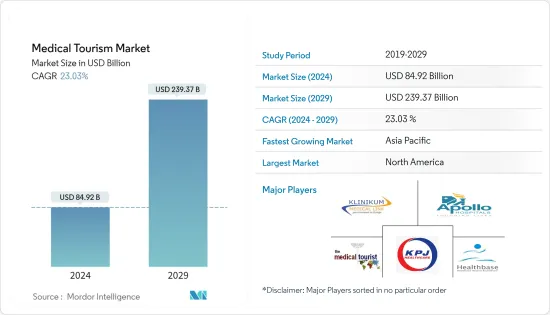
COVID-19パンデミックは、移動の制限、サプライチェーンの混乱、旅行禁止などにより、インド、中国、その他の新興国など人気の高いメディカルツーリズム目的地を含むメディカルツーリズム市場に大きな影響を与えています。パンデミックの最初の2年間の渡航制限は、インドのメディカルツーリズムに悪影響を与えました。例えば、フォルティス・医療の年次報告書によると、2021年、世界の渡航制限により、近隣諸国からの訪問患者の流れが止まり、メディカルツーリズム分野に大きな影響を与えました。さらに、2022年11月にBusiness Standardsが発表した記事によると、2022年3月から4月にかけて国際便が就航し、国際旅行がCOVID-19以前のレベルになるにつれて、COVID-19パンデミックに見舞われた2年間にほぼゼロになったメディカルツーリズムがインドで増加すると予想されています。この状況を打開するため、さまざまな政府が率先してメディカルツーリズムを国内に呼び戻そうとしています。例えば、メキシコは観光客を誘致するため、2022年6月中旬に#Come2MexicanCaribbeanキャンペーンを導入し、旅行者にホテル無料宿泊、レンタカー割引、観光名所での割引などのプレゼントやパスを提供しています。このように、メディカルツーリズムに対する政府の規制や取り組みが高揚することで、市場は今後数年でCOVID-19の影響から回復すると予想されます。
新興諸国における治療費の低下、最新の医療技術の利用可能性、国際的な品質基準やサービスへの準拠の高まり、メディカルツーリズムの広告・マーケティングなどの要因が、予測期間中の市場成長を促進すると予想されます。例えば、2022年9月、インド政府のMoHFWは、国内のメディカルツーリズムを促進するための新たな取り組みを開始しました。例えば、165カ国の医療目的でインドに渡航する観光客への医療ビザの提供、メディカルツーリズム客から体験談を得るためのフィードバック機構の設置、インドをメディカルツーリズムの世界的ハブとして位置づけるための「Heal in India」イニシアチブなどです。また、中国のボアオ・レチェン政府が2021年12月に発表した記事によると、海南ボアオ・レチェン国際メディカルツーリズムパイロットゾーンでは、幹細胞、免疫細胞、遺伝子治療、さらに生物医学分野のその他の新しい技術に関する研究の進展を促進するための取り組みが行われました。この医療パイロットゾーンでは、オーストラリア、ブルネイ、カンボジア、中国、インドネシア、日本、ラオス、マレーシア、ミャンマー、ニュージーランド、フィリピン、シンガポール、韓国、タイ、ベトナムの15カ国の人々がRCEPに参加し、治療を受けに来ることを奨励しました。このようなメディカルツーリズムの取り組みは、成長を促進すると予想されます。
加えて、先進諸国における高額な医療費は、新興国における市場成長の大きな原動力になると予想されます。例えば、World Population Review 2022によると、ほとんどの先進国では医療費は税金、民間保険、民間団体による補助金で賄われています。米国はユニークなことに、医療システムにおいてこれらすべての支払い方法を採用しています。その他の新興諸国は、政府プログラムを通じて徴収された税金で必要な医療費が賄われる単一支払い制度に参加しています。さらに、AMAの2022年11月の報告書によると、1人当たりの医薬品支出は、米国では1,443米ドルであるのに対し、他国では466米ドルから939米ドルです。このように、先進国に比べて医療費が安いため、人々は医療のために新興諸国を訪れ、最終的に市場の成長を促しています。したがって、メディカルツーリズム市場は上記の要因から予測期間中に成長すると予想されます。しかし、患者のフォローアップ、治療後の合併症、医療記録の移転などの問題が、予測期間中の市場成長の妨げになると予想されます。
メディカルツーリズム市場の動向
美容治療セグメントは予測期間中に健全な成長率が見込まれる
美容メディカルツーリズムとは、患者が自国での待ち行列やアクセス、費用面の制約、法的要件を回避するために海外で美容整形を受ける現象です。美容メディカルツーリズムで求められる標準的な施術には、豊胸、脂肪吸引、フェイスリフト、タミータック、眼瞼手術、鼻の整形などがあります。美容施術に対する患者の支出の増加と美容施術のために旅行する意欲は、市場を牽引すると予想されます。例えば、ASPS Insights and Trend Report 2022によると、患者の59%は「やや多めに」出費することを望んでおり、17%は美容整形に対する患者の出費が大幅に増加することを指摘しています。さらに、Aesthetic Plastic Surgery National Databank 2020~2021によると、米国では外科手術が54%増加し、非外科手術は44%増加しました。このような美容整形手術の増加に伴い、治療ツーリズムの需要が増加し、市場の成長を牽引しています。
さらに、G/O Media Inc.が発表した記事によると、2022年8月、米国ではわずか6%であったのに対し、日本ではまぶたの手術が美容治療全体の65%を占めています。トルコは整形手術のメディカルツーリズム先として人気があり、特に鼻整形は中東諸国の人々の間で最も頻繁に行われている治療です。このような報告は、美容治療のための観光客の増加を実証しており、同分野の成長を促進すると予想されます。
したがって、美容治療セグメントは、上記の要因により、予測期間中に大きな成長を示すと推定されます。
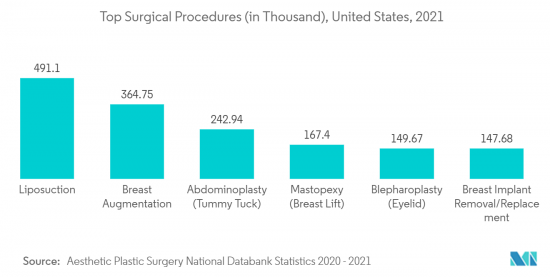
アジア太平洋が予測期間中に大きな市場シェアを占めると予測される
アジア太平洋は、同地域の新興国市場全体におけるメディカルツーリズムへの嗜好、政府による取り組み、同地域の医療費の低さなどにより、大きな市場シェアを占めると予想されます。インドの医療は、欧米諸国や中東諸国よりもかなり安価です。IJIRAによると、2021年12月、インドの医療治療費は欧州と比較して約50%安かった。また、ここでの治療費はアメリカに比べて65%から90%節約できます。このような統計は、世界のメディカルツーリズムにおけるアジア太平洋諸国の牙城を示しています。
さらに、アジア太平洋諸国の政府による取り組みも、同地域の市場成長を促進すると期待されています。例えば、2022年4月、インド政府は、伝統医学の治療や観光のためにインドを訪れる観光客のためにAYUSHビザという特定のカテゴリーを立ち上げることを計画しました。このイニシアチブは、インドのメディカルツーリズムを促進するための政府の「Heal In India」キャンペーンの一環です。さらに、2022年2月、日本は観光客を誘致するために「ウェルネス」施設を含むヘルスツーリズムの提供を拡大しました。ウェルネス施設には、スパ、ヨガ、瞑想クラス、フィットネス・プログラムなどが含まれます。
さらに2022年9月、韓国保健産業振興院(KHIDI)はメディカル・コリアの公式ウェブサイトを刷新し、韓国の医療サービスの利用に関連する情報を掲載しました。がん、循環器、臓器移植を含む専門医療分野の手術や治療に関するレポートがメディカル・コリアのウェブサイトに掲載され、外国人患者を治療するために指定されたクリニックや病院が掲載されています。政府によるこのような取り組みが、予測期間中の市場の成長を後押しすると予想されます。
このように、同市場は上記の要因により、予測期間中にアジア太平洋で健全な成長を遂げることが期待されています。
メディカルツーリズム産業概要
世界のメディカルツーリズム市場は適度な競争があり、複数の大手企業が存在します。市場シェアでは、現在、少数の大手企業が市場を独占しています。競合情勢には、Healthbase、Apollo Hospitals、KPJ Healthcare、Klinikum Medical Linkなど、市場シェアを持ち知名度の高い国際企業や地元企業の分析が含まれます。
その他の特典:
- エクセル形式の市場予測(ME)シート
- 3ヶ月間のアナリスト・サポート
目次
第1章 イントロダクション
- 調査の前提条件と市場定義
- 調査範囲
第2章 調査手法
第3章 エグゼクティブサマリー
第4章 市場力学
- 市場概要
- 市場促進要因
- 先進諸国における高い治療費
- 最新の医療技術と質の高いサービスの提供
- 国際品質基準への準拠の高まり
- 市場抑制要因
- 患者のフォローアップと処置後の合併症の問題
- 医療記録移転の問題
- ポーターのファイブフォース分析
- 新規参入業者の脅威
- 買い手・消費者の交渉力
- 供給企業の交渉力
- 代替品の脅威
- 競争企業間の敵対関係の強さ
第5章 市場セグメンテーション(市場規模-100万米ドル)
- 治療タイプ別
- 美容治療
- 歯科治療
- 心臓血管治療
- 整形外科治療
- 肥満治療
- 不妊治療
- 眼科治療
- その他の治療
- 地域
- 北米
- 米国
- カナダ
- メキシコ
- 欧州
- ドイツ
- 英国
- フランス
- イタリア
- スペイン
- その他の欧州
- アジア太平洋
- 中国
- 日本
- インド
- オーストラリア
- 韓国
- その他のアジア太平洋
- 中東・アフリカ
- GCC諸国
- 南アフリカ
- その他の中東とアフリカ
- 南米
- ブラジル
- アルゼンチン
- その他の南米
- 北米
第6章 競合情勢
- 企業プロファイル
- Medretreat
- Healthbase
- Apollo Hospitals
- KPJ Healthcare Behard
- Klinikum Medical Link
- Euromedical Tours
- BB Health Solutions
- Cosmedic Travel
- Aditya Birla Memorial Hospital
- Fortis Healthcare Limited
- NTT Medical Center Tokyo
- Prince Court Medical Centre
第7章 市場機会と今後の動向

The Medical Tourism Market size is estimated at USD 84.92 billion in 2024, and is expected to reach USD 239.37 billion by 2029, growing at a CAGR of 23.03% during the forecast period (2024-2029).
The COVID-19 pandemic has significantly impacted the medical tourism markets, including popular medical tourism destinations such as India, China, and other emerging countries, due to restrictions in movement, supply chain disruption, travel bans, etc. Travel restrictions in the first two years of the pandemic had an adverse impact on medical tourism in India. For instance, as per Fortis Healthcare's annual report, in 2021, restrictions on global travel substantially impacted the medical tourism segment as the flow of visiting patients from neighboring countries halted. Furthermore, according to an article published by Business Standards in November 2022, medical tourism is expected to increase in India after being nearly reduced to zero during the two years hit by the COVID-19 pandemic as international flights opened in March-April 2022 and international travel comes to pre-COVID levels. Various governments are taking the initiative to bring medical tourism back into the country to overcome the situation. For instance, to entice tourists, Mexico introduced the #Come2MexicanCaribbean campaign in mid-June 2022, which offers gifts and passes to travelers, such as free hotel stays, discounted vehicle rentals, and discounts at tourist attractions. Thus, with the upliftment of government restrictions and initiatives toward medical tourism, the market is expected to recover from the effects of COVID-19 in the next few years.
Factors such as lower treatment costs in developing countries, availability of the latest medical technologies, growing compliance with international quality standards and service, and advertising and marketing of medical tourism are expected to drive market growth over the forecast period. For instance, in September 2022, the MoHFW of the Indian Government commenced new initiatives to boost medical tourism in the country. Such as providing medical visas for tourists traveling to India for healthcare purposes in 165 countries, setting up a feedback mechanism to obtain testimonials from medical tourists, and the 'Heal in India' initiative to position India as a global hub for medical tourism. Also, according to an article published by the government of Boao Lecheng, China, in December 2021, efforts were taken by the Hainan Boao Lecheng International Medical Tourism Pilot Zone to promote the research progress on stem cell, immune cell, and gene therapy, plus other new techniques in the biomedical sector. The medical pilot zone encouraged people from 15 countries, such as Australia, Brunei, Cambodia, China, Indonesia, Japan, Laos, Malaysia, Myanmar, New Zealand, Philippines, Singapore, South Korea, Thailand, and Vietnam, to join the RCEP to come for treatment. Such an initiative in medical tourism is expected to drive growth.
In addition, high healthcare costs in developed countries are expected to be a significant driving factor for the market growth in developing countries. For instance, according to World Population Review 2022, healthcare is financed through taxes, private insurance, or subsidized by private organizations in most developed countries. The United States uniquely uses all these payment methods in its healthcare system. Other developing countries participate in a single-payer system, in which essential healthcare costs are paid for by taxes collected through government programs. Furthermore, as per the November 2022 report of AMA, pharmaceutical spending per capita was USD 1,443 in the United States, whereas it ranges from USD 466 to USD 939 in other countries. Thus, people visit developing countries for medical treatment because of the low cost compared to developed countries, eventually driving the market's growth. Therefore, the medical tourism market is expected to grow over the forecast period due to the abovementioned factors. However, issues with patient follow-up, post-procedure complications, and medical record transfer issues are expected to hinder market growth over the forecast period.
Medical Tourism Market Trends
Cosmetic Treatment Segment Expected to Have Healthy Growth Rate Over the Forecast Period
Cosmetic treatment tourism is the phenomenon of patients seeking cosmetic surgery overseas to avoid waiting lists, access, cost constraints, or legal requirements in their native country. Standard procedures requested under cosmetic treatment tourism include breast augmentation, liposuction, facelift, tummy tucks, eyelid surgery, and nose reshaping. The increased patient spending on cosmetic procedures and willingness to travel for a cosmetic procedure is expected to drive the market. For instance, as per the ASPS Insights and Trend Report 2022, 59% of patients are willing to spend "somewhat more," and 17% noted a substantial increase in patient spending for cosmetic procedures. Furthermore, according to the Aesthetic Plastic Surgery National Databank 2020-2021, surgical procedures increased by 54%, and non-surgical procedures were up by 44% in the United States. With such an increase in cosmetic procedures, the demand for treatment tourism increases, driving the market's growth.
Furthermore, according to an article published by G/O Media Inc., in August 2022, compared to just 6% in the United States, eyelid surgery accounted for 65% of all cosmetic treatments in Japan. Turkey is a popular medical tourism destination for plastic surgeries, and Rhinoplasties are the most often performed treatment, particularly among people from Middle Eastern nations. Such reports demonstrating the increasing number of tourists for cosmetic treatments are expected to propel the segment's growth.
Hence, the cosmetic treatment segment is estimated to witness significant growth over the forecast period due to the abovementioned factors.

Asia-Pacific Region is Expected to Hold Significant Market Share Over the Forecast Period
The Asia-Pacific region is expected to hold a significant market share owing to the preference for medical tourism across the region's developing countries, initiatives taken by the government, and the low cost of medical treatment in this region. Healthcare in India is significantly less expensive than in Western and Middle Eastern countries. According to IJIRA, in December 2021, the cost of medical care and treatment in India was about 50% less compared to Europe. Also, there is a 65% to 90% savings on treatment here compared to America. Such statistics demonstrate the stronghold of Asia-Pacific countries in medical tourism worldwide.
Additionally, the initiatives taken by the governments of Asia-Pacific countries are also expected to propel the market's growth in the region. For instance, in April 2022, the Government of India planned to launch a particular category of AYUSH visas for tourists visiting India for medical treatment or tourism in traditional medicine. This initiative is a part of the government's "Heal In India" campaign to promote medical tourism in India. Additionally, in February 2022, Japan expanded its health tourism offerings by including "wellness" facilities to attract tourists. The wellness offerings include spas, yoga and meditation classes, and fitness programs.
Furthermore, in September 2022, Korea Health Industry Development Institute (KHIDI) revamped the official website of Medical Korea, featuring information related to the use of Korean medical services. Reports on operations and treatment of medical specialties, including oncology, cardiology, and organ transplantation, are available on the Medical Korea website, which lists clinics and hospitals designated to treat foreign patients. Such initiatives undertaken by the government are expected to boost the market's growth over the forecast period.
Thus, the market is expected to witness healthy growth in the Asia-Pacific region over the forecast period due to the abovementioned factors.
Medical Tourism Industry Overview
The global medical tourism market is moderately competitive and has several major players. In terms of market share, few of the major players currently dominate the market. The competitive landscape includes an analysis of a few international and local companies that hold market shares and are well-known, including Healthbase, Apollo Hospitals, KPJ Healthcare, and Klinikum Medical Link, among others.
Additional Benefits:
- The market estimate (ME) sheet in Excel format
- 3 months of analyst support
TABLE OF CONTENTS
1 INTRODUCTION
- 1.1 Study Assumptions and Market Definition
- 1.2 Scope of the Study
2 RESEARCH METHODOLOGY
3 EXECUTIVE SUMMARY
4 MARKET DYNAMICS
- 4.1 Market Overview
- 4.2 Market Drivers
- 4.2.1 High Treatment Cost in Developed Countries
- 4.2.2 Availability of Latest Medical Technologies and High Quality of Service
- 4.2.3 Growing Compliance of International Quality Standards
- 4.3 Market Restraints
- 4.3.1 Issues with Patient Follow Up and Post-procedure Complications
- 4.3.2 Medical Record Transfer Issues
- 4.4 Porter's Five Forces Analysis
- 4.4.1 Threat of New Entrants
- 4.4.2 Bargaining Power of Buyers/Consumers
- 4.4.3 Bargaining Power of Suppliers
- 4.4.4 Threat of Substitute Products
- 4.4.5 Intensity of Competitive Rivalry
5 MARKET SEGMENTATION (Market Size by Value - USD million)
- 5.1 By Treatment Type
- 5.1.1 Cosmetic Treatment
- 5.1.2 Dental Treatment
- 5.1.3 Cardiovascular Treatment
- 5.1.4 Orthopedics Treatment
- 5.1.5 Bariatric Surgery
- 5.1.6 Fertility Treatment
- 5.1.7 Ophthalmic Treatment
- 5.1.8 Other Treatments
- 5.2 Geography
- 5.2.1 North America
- 5.2.1.1 United States
- 5.2.1.2 Canada
- 5.2.1.3 Mexico
- 5.2.2 Europe
- 5.2.2.1 Germany
- 5.2.2.2 United Kingdom
- 5.2.2.3 France
- 5.2.2.4 Italy
- 5.2.2.5 Spain
- 5.2.2.6 Rest of Europe
- 5.2.3 Asia-Pacific
- 5.2.3.1 China
- 5.2.3.2 Japan
- 5.2.3.3 India
- 5.2.3.4 Australia
- 5.2.3.5 South Korea
- 5.2.3.6 Rest of Asia-Pacific
- 5.2.4 Middle East and Africa
- 5.2.4.1 GCC
- 5.2.4.2 South Africa
- 5.2.4.3 Rest of Middle East and Africa
- 5.2.5 South America
- 5.2.5.1 Brazil
- 5.2.5.2 Argentina
- 5.2.5.3 Rest of South America
- 5.2.1 North America
6 COMPETITIVE LANDSCAPE
- 6.1 Company Profiles
- 6.1.1 Medretreat
- 6.1.2 Healthbase
- 6.1.3 Apollo Hospitals
- 6.1.4 KPJ Healthcare Behard
- 6.1.5 Klinikum Medical Link
- 6.1.6 Euromedical Tours
- 6.1.7 BB Health Solutions
- 6.1.8 Cosmedic Travel
- 6.1.9 Aditya Birla Memorial Hospital
- 6.1.10 Fortis Healthcare Limited
- 6.1.11 NTT Medical Center Tokyo
- 6.1.12 Prince Court Medical Centre
